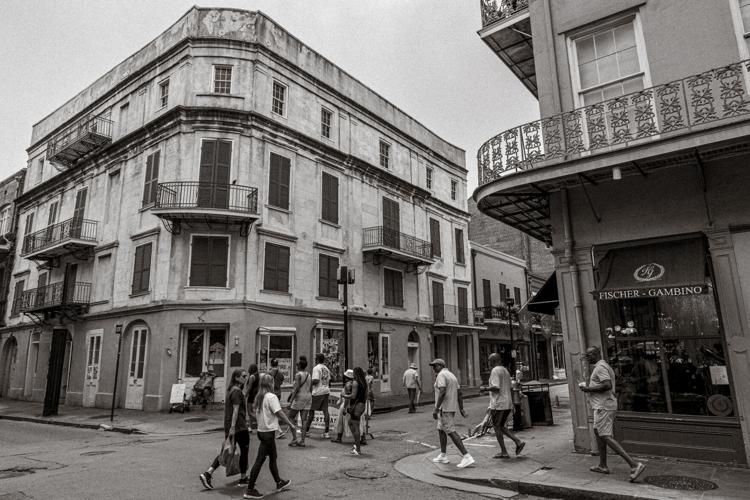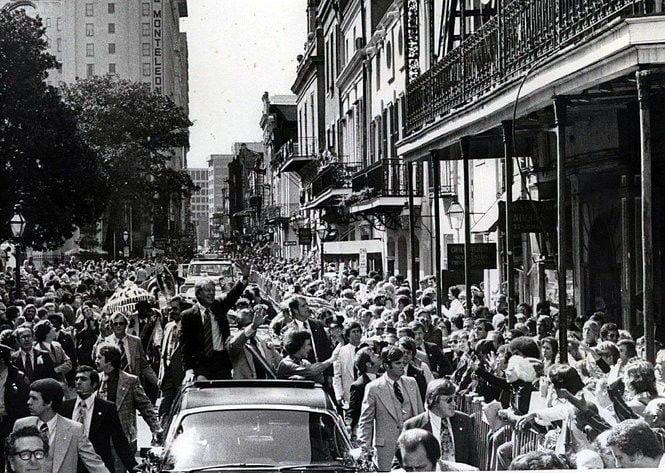Mary Anne O’Neil lives in Walla Walla, Washington, which is roughly 2,300 miles from where she grew up, on Versailles Boulevard in Broadmoor. She went to Ecole Classique High School on Napolean Avenue, then left town to pursue an education and teaching career.
O’Neil is 78. She is professor emerita of French at Whitman College in Walla Walla, but you can tell, after all these years, she keeps one foot planted in the Crescent City.
In 2022, she wrote the book “Three Centuries of Girls’ Education: Regulations of the Ursuline Nuns of the Congregation of Paris.”
Yep, those Ursuline nuns, the ones who brought a measure of godliness to the French Quarter way back in the 1700s. Or tried to, anyway.

A normal day in the Vieux Carre
Which brings us to O’Neil’s deceptively simple question: Where does the English term “French Quarter” come from? And when was it first used?
According to Tulane professor Richard Campanella’s book “Bourbon Street,” the earliest map of what would become the French Quarter was a crude 1721 sketch titled “Plan de la Ville de la Nouvelle Orleans projettée en Mars 1721” or “Plan of the City of New Orleans projected in March 1721.”
For years and years to come, the term Nouvelle Orleans was pretty much all you needed, terminology-wise. The whole burgeoning city was what we now call the French Quarter. That’s all there was. When the Spanish took over in the 1760s, the term they used was just Nueva Orleans.

Carriage driver Charlotte Jones and her mule, Chica, pass in front of Tujague's Restaurant in New Orleans on Thursday, October 10, 2019.
As any mule-driving tour guide could tell you, the term French Quarter is a misnomer. The Good Friday fire of 1788 turned 80% of the original, wooden French enclave to ashes. The Spanish, who were still in charge, decreed that the town be rebuilt in relatively fireproof brick and plaster.
So, when you think about it, the old French Quarter is really the newish Spanish Quarter. Though nobody ever calls it that.
Campanella said that 1788 was important to our discussion of nomenclature, because after the inferno, New Orleans’ first suburb, the Suburbio Santa Maria, popped up, more or less where the CBD is now.
And if there’s a new section of town, then you have to call the old section something else, right?

Old balconies in the French Quarter of New Orleans on Thursday, May 18, 2023.
Over the next decades, the place most of us just call the Quarter was known by various logical, descriptive titles, including the Old City, the Creole Quarter and the Latin Quarter.
Linguist and researcher Drew Ward said the term "Quarter" was probably originally plural. “It doesn’t actually refer to ‘a quarter’ as in a sector of a city, but rather to ‘quarters’ as in the place where a given group lived.”
After the Louisiana Purchase in 1803, as more and more “Americans” took up residence above Canal Street, the town was divided between the American Quarters and the French Quarters, according to Ward.
Ward said he’s not sure how the term Vieux Carré became part of the picture. “It means ‘old square’ or ‘old part of the city,’” he said. But, the bigger question is, “when did we start calling it that?”
“In a city that’s not that old, at which point was the original part of the city considered old enough to be called the ‘old city’ by locals?" Ward mused.
Apparently at the turn of the 20th century. Ward discovered that in the 1900 “Tourists Guide Book to the City Of New Orleans,” published by The Picayune newspaper, the author explains that the original settlement is “now called the vieux carré.”
“Which tells you that, as of 1900, calling the French Quarter the vieux carré was a relatively new thing,” Ward concluded.
Campanella concurred, adding that Vieux Carré was a term that had been around for a while before it became standardized as a proper noun, probably in the early 20th century.
At about the same time, the neighborhood earned one of its lesser-known nicknames. From the 1880s to the 1920s, a wave of Sicilian immigrants settled in the rundown old square, and the term “Little Palermo” temporarily caught on.

Finally, we’re back to O’Neil’s question: Where does the English term “French Quarter” come from? And when was it first used?
“Well,” Campanella said, “as you surely suspect, it was a gradual, incremental process.” Like the term Vieux Carré, the term French Quarter lent a certain je ne sais quoi to the picturesque neighborhood.
“By the early 1900s, with English now the predominant language, 'the French quarter or quarters' became standard,” Campanella said.
Campanella suspects the final codification may have taken place in about 1937, after the Vieux Carre Commission was granted regulatory power to preserve the neighborhood, followed by the rise of the tourism trade.
This, Campanella said, “led to the uppercase, formal, proper noun, French Quarter.”
Who knows how these things get started? More than one reader asked if it was really true that sorority houses are not allowed in New Orleans, …
Ghosts are apparently common in Louisiana. Like an LSU game on the TV or a bottle of hot sauce in the pantry, you can usually count on finding…
You’d think that the origin of one of New Orleans’ most iconic turns of phrase would be well known. But you’d be mistaken.










